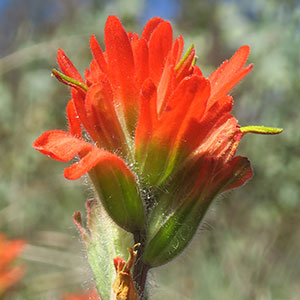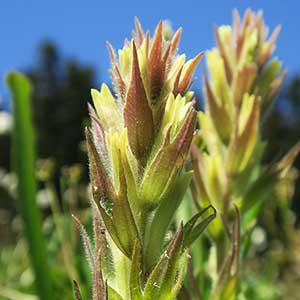|
short-lobed paintbrush
|
Mt. Rainier or obscure paintbrush, obscure Indian paintbrush, obscure paintbrush
|
| Herbs, perennial, 1–5 dm; from a branched, woody caudex; with a taproot. |
Herbs, perennial, (0.8–)1–1.9 dm; from a woody caudex; with a taproot. |
solitary or few, erect or ascending, unbranched, sometimes branched, hairs spreading, short, medium, and long, soft, short and medium ones short stipitate-glandular. |
few to several, erect or ascending, unbranched, hairs spreading, long, soft, eglandular, mixed with short stipitate-glandular ones. |
green or ± yellow, lanceolate, elliptic, or oblong to narrowly ovate, 1–2(–2.5) cm, not fleshy, margins plane or wavy, involute, (0–)3–5(–7)-lobed, apex rounded to acute; lobes ascending to erect, linear to lanceolate, apex rounded to acute. |
green, often with brown or purple veins, narrowly to broadly lanceolate, 1.5–4 cm, not fleshy, margins plane, ± involute, 0–3-lobed, apex acute to acuminate; lobes spreading-ascending, narrowly lanceolate, apex acute to ± obtuse. |
3–20 × 2–3.5 cm; bracts proximally greenish to dull brown, distally red, orange-red, or scarlet, sometimes orange or yellow, broadly lanceolate or oblong, (0–)3–5-lobed; lobes ascending, broadly to narrowly lanceolate, short, arising above mid length, apex acute, obtuse, or rounded. |
(2.5–)3–6 × 1–2 cm; green to dull brown or dull reddish purple throughout, or proximally green to dull brown or dull reddish purple, distally yellow on apices, broadly lanceolate to ovate, (0–)3-lobed; lobes ascending, narrowly lanceolate, long or short, arising near mid length, apex acute or acuminate. |
straight, 15–24(–26) mm; tube 12–16 mm; beak exserted, abaxial lip equal to calyx; beak adaxially green or ± yellow-green, 7–10 mm, puberulent, stipitate-glandular; abaxial lip deep green, reduced, rounded, 1–2 mm, 10–25% as long as beak; teeth incurved to erect, light green, 0.5–1 mm. |
straight, 14–16 mm; tube 11–14 mm; whole corolla included within calyx; beak adaxially pale yellow, 1–2 mm; abaxial lip deep green, slightly inflated, 4–5 mm, 67% as long as beak; teeth ascending, pale, 1.5–2 mm. |
green or whitish with green veins, lobes colored as bract lobes or paler, 14–30 mm; abaxial and adaxial clefts 5.5–8.5 mm, 30–40% of calyx length, deeper than laterals, lateral 1.5–4 mm, 20–25% of calyx length; lobes oblong to narrowly triangular, apex obtuse to rounded. |
proximally green or pale with green veins, lobes yellow, sometimes becoming deep red with age, 12–15 mm; abaxial and adaxial clefts 3–7 mm, 25–50% of calyx length, deeper than laterals, lateral 1–3(–4) mm, 8–20% of calyx length; lobes triangular, adaxial segments longer than abaxials, apex acute or obtuse. |
= 24. |
= 24. |
|
|
|
|
| Flowering Mar–Aug. |
Flowering Jul–Aug. |
| Dry savannas, rocky slopes and open conifer forests, on serpentine. |
Mesic to moist flat subalpine meadows and turf, to tree line. |
| 200–1700 m. (700–5600 ft.) |
1500–2000 m. (4900–6600 ft.) |
|
CA; OR
|
WA
|
Castilleja brevilobata is endemic to dry serpentine openings in the Siskiyou Mountains of southwestern Oregon and adjacent California. Although sometimes treated as part of C. applegatei or C. hispida, its morphology does not suggest a close connection with either. This species occasionally hybridizes with C. pruinosa in Del Norte County, California. (Discussion copyrighted by Flora of North America; reprinted with permission.) |
Castilleja cryptantha is endemic to the vicinity of Mt. Rainier in the Cascade Range, with most populations found within Mt. Rainier National Park. Unlike most species of Castilleja, it is apparently self-pollinating (W. J. Duffield 1972); the small flowers are entirely enclosed within the yellowish calyces, which tend to grow deep reddish as they age. The purplish brown bracts are also unusual in the genus. (Discussion copyrighted by Flora of North America; reprinted with permission.) |
| FNA vol. 17, p. 591. |
FNA vol. 17, p. 600. |
| Orobanchaceae > Castilleja |
Orobanchaceae > Castilleja |
C. affinis, C. ambigua, C. angustifolia, C. applegatei, C. aquariensis, C. arachnoidea, C. attenuata, C. brevistyla, C. campestris, C. cervina, C. chambersii, C. chlorotica, C. christii, C. chromosa, C. chrymactis, C. chrysantha, C. cinerea, C. citrina, C. coccinea, C. collegiorum, C. covilleana, C. crista-galli, C. cryptantha, C. cusickii, C. densiflora, C. dissitiflora, C. disticha, C. elata, C. elegans, C. elmeri, C. exserta, C. flava, C. foliolosa, C. fraterna, C. genevieveana, C. glandulifera, C. gleasoni, C. gracillima, C. grisea, C. haydenii, C. hispida, C. hololeuca, C. hyperborea, C. indivisa, C. integra, C. kaibabensis, C. kerryana, C. kraliana, C. lacera, C. lanata, C. lasiorhyncha, C. lassenensis, C. latifolia, C. lemmonii, C. leschkeana, C. levisecta, C. linariifolia, C. lindheimeri, C. lineariloba, C. lineata, C. litoralis, C. lutescens, C. martini, C. mendocinensis, C. mexicana, C. miniata, C. minor, C. mogollonica, C. mollis, C. montigena, C. nana, C. nelsonii, C. nervata, C. nivea, C. occidentalis, C. oresbia, C. organorum, C. ornata, C. pallescens, C. pallida, C. parviflora, C. parvula, C. patriotica, C. peckiana, C. peirsonii, C. pilosa, C. plagiotoma, C. praeterita, C. pruinosa, C. puberula, C. pulchella, C. purpurascens, C. purpurea, C. raupii, C. revealii, C. rhexiifolia, C. rigida, C. rubicundula, C. rubida, C. rupicola, C. salsuginosa, C. scabrida, C. schizotricha, C. septentrionalis, C. sessiliflora, C. subinclusa, C. suksdorfii, C. tenuiflora, C. tenuis, C. thompsonii, C. tomentosa, C. uliginosa, C. unalaschcensis, C. victoriae, C. viscidula, C. wightii, C. wootonii, C. xanthotricha |
C. affinis, C. ambigua, C. angustifolia, C. applegatei, C. aquariensis, C. arachnoidea, C. attenuata, C. brevilobata, C. brevistyla, C. campestris, C. cervina, C. chambersii, C. chlorotica, C. christii, C. chromosa, C. chrymactis, C. chrysantha, C. cinerea, C. citrina, C. coccinea, C. collegiorum, C. covilleana, C. crista-galli, C. cusickii, C. densiflora, C. dissitiflora, C. disticha, C. elata, C. elegans, C. elmeri, C. exserta, C. flava, C. foliolosa, C. fraterna, C. genevieveana, C. glandulifera, C. gleasoni, C. gracillima, C. grisea, C. haydenii, C. hispida, C. hololeuca, C. hyperborea, C. indivisa, C. integra, C. kaibabensis, C. kerryana, C. kraliana, C. lacera, C. lanata, C. lasiorhyncha, C. lassenensis, C. latifolia, C. lemmonii, C. leschkeana, C. levisecta, C. linariifolia, C. lindheimeri, C. lineariloba, C. lineata, C. litoralis, C. lutescens, C. martini, C. mendocinensis, C. mexicana, C. miniata, C. minor, C. mogollonica, C. mollis, C. montigena, C. nana, C. nelsonii, C. nervata, C. nivea, C. occidentalis, C. oresbia, C. organorum, C. ornata, C. pallescens, C. pallida, C. parviflora, C. parvula, C. patriotica, C. peckiana, C. peirsonii, C. pilosa, C. plagiotoma, C. praeterita, C. pruinosa, C. puberula, C. pulchella, C. purpurascens, C. purpurea, C. raupii, C. revealii, C. rhexiifolia, C. rigida, C. rubicundula, C. rubida, C. rupicola, C. salsuginosa, C. scabrida, C. schizotricha, C. septentrionalis, C. sessiliflora, C. subinclusa, C. suksdorfii, C. tenuiflora, C. tenuis, C. thompsonii, C. tomentosa, C. uliginosa, C. unalaschcensis, C. victoriae, C. viscidula, C. wightii, C. wootonii, C. xanthotricha |
| C. hispida subsp. brevilobata |
|
| Piper: Proc. Biol. Soc. Wash. 33: 104. (1920) |
Pennell & G. N. Jones: Proc. Biol. Soc. Wash. 50: 208. (1937) |
| |



